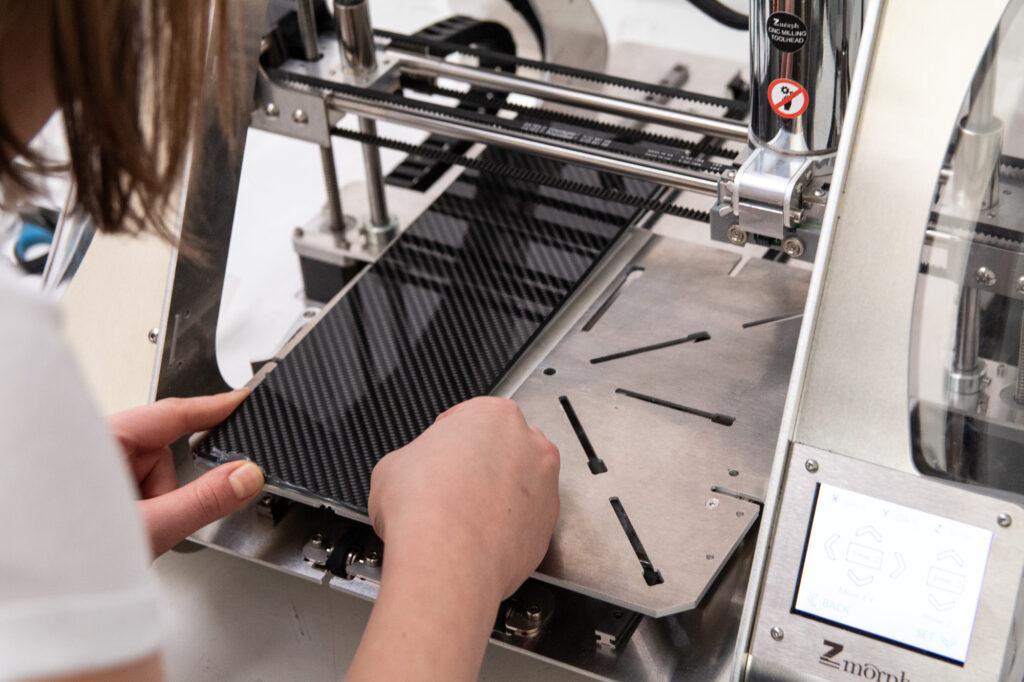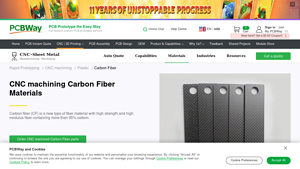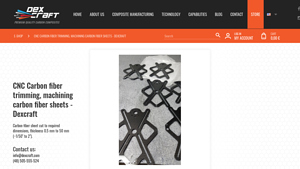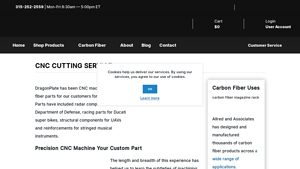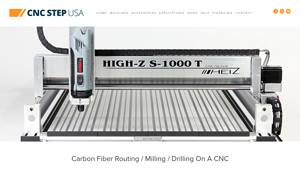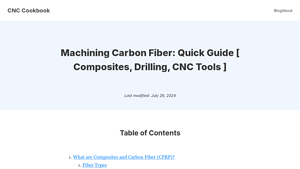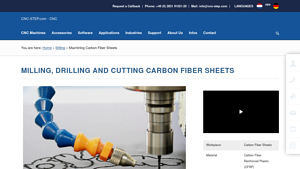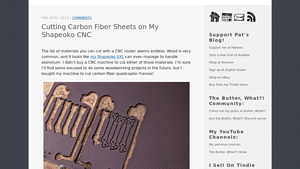Carbon Fiber Cnc Machine Guide: Type, Cost, Top List…
Introduction: Navigating the Global Market for carbon fiber cnc machine
The increasing demand for high-performance materials in industries such as aerospace, automotive, and medical is pushing B2B buyers to seek efficient solutions for sourcing carbon fiber CNC machines. Navigating the global market for these specialized machines can be daunting, given the complexity of the material properties and the precision required in machining processes. This guide serves as a comprehensive resource for international buyers, covering essential aspects such as types of CNC machines available, their applications across various sectors, and strategies for effective supplier vetting.
In addition to providing insights into the cost structures associated with carbon fiber CNC machining, this guide empowers decision-makers by outlining critical considerations for evaluating potential suppliers. From understanding the nuances of carbon fiber material behavior during machining to ensuring compliance with international quality standards, our aim is to equip businesses, especially those in Africa, South America, the Middle East, and Europe, with the knowledge needed to make informed purchasing decisions.
By addressing common challenges faced in sourcing carbon fiber CNC machines, this guide not only clarifies the selection process but also highlights best practices for optimizing production efficiency and reducing operational costs. With a focus on actionable insights and expert recommendations, we are committed to helping B2B buyers navigate this dynamic market landscape effectively.
Understanding carbon fiber cnc machine Types and Variations
| Type Name | Key Distinguishing Features | Primary B2B Applications | Brief Pros & Cons for Buyers |
|---|---|---|---|
| 3-Axis CNC Machines | Simple design, limited movement in three axes | Prototyping, small parts production | Pros: Cost-effective, easy to operate. Cons: Limited complexity in designs. |
| 4-Axis CNC Machines | Additional rotational axis for complex cuts | Aerospace components, automotive parts | Pros: Greater versatility, improved precision. Cons: Higher cost, requires skilled operators. |
| 5-Axis CNC Machines | Full spatial movement, capable of intricate designs | Medical devices, complex assemblies | Pros: High precision, can handle complex geometries. Cons: Expensive, requires advanced programming skills. |
| Waterjet CNC Machines | Uses high-pressure water for cutting | Aerospace, custom parts fabrication | Pros: No heat distortion, versatile for different materials. Cons: Slower than traditional CNC, higher maintenance. |
| Laser CNC Machines | Utilizes laser technology for cutting and engraving | Electronics, decorative components | Pros: High accuracy, smooth finishes. Cons: Limited thickness capability, higher initial investment. |
What are the Characteristics of 3-Axis CNC Machines in Carbon Fiber Processing?
3-axis CNC machines are the foundational technology in carbon fiber machining. They operate on three linear axes—X, Y, and Z—allowing for basic milling and cutting operations. Ideal for prototyping and small parts production, they are often favored by businesses looking to minimize costs while achieving satisfactory results. Buyers should consider their application needs, as these machines may not suffice for complex geometries.
How Do 4-Axis CNC Machines Enhance Carbon Fiber Machining?
4-axis CNC machines introduce an additional rotational axis, enabling more complex cuts and shapes. This capability is particularly beneficial in the aerospace and automotive sectors, where precision is critical. While they offer improved versatility over 3-axis machines, the higher cost and need for skilled operators are significant considerations for potential buyers.
Why Choose 5-Axis CNC Machines for Complex Carbon Fiber Applications?
5-axis CNC machines provide the highest level of complexity and precision in carbon fiber machining. With movement across five axes, they can create intricate designs that are essential for industries like medical devices and high-performance automotive components. Although they come with a steep price tag and require advanced programming skills, their ability to produce complex geometries makes them invaluable for businesses prioritizing innovation.
What Advantages Do Waterjet CNC Machines Offer for Carbon Fiber Cutting?
Waterjet CNC machines utilize high-pressure water to cut through materials, making them a unique option for carbon fiber applications. They are particularly effective in industries such as aerospace, where precision is paramount, and heat distortion must be avoided. While they provide versatility for various materials, they are generally slower than traditional CNC methods and may require more maintenance.
How Are Laser CNC Machines Revolutionizing Carbon Fiber Manufacturing?
Laser CNC machines employ laser technology for cutting and engraving carbon fiber, offering unparalleled accuracy and smooth finishes. These machines are particularly suitable for the electronics sector and for creating decorative components. However, their limitations in handling thicker materials and the higher initial investment may deter some buyers, making it essential to evaluate specific project requirements before purchase.
Key Industrial Applications of carbon fiber cnc machine
| Industry/Sector | Specific Application of carbon fiber cnc machine | Value/Benefit for the Business | Key Sourcing Considerations for this Application |
|---|---|---|---|
| Aerospace & Aviation | Manufacturing of lightweight aircraft components | Reduces fuel consumption and increases performance | Certifications for aerospace-grade materials; precision machining capabilities; compliance with industry standards. |
| Automotive | Production of high-performance automotive parts | Enhances vehicle performance and reduces weight | Sourcing from suppliers with experience in automotive specifications; focus on durability and compliance with safety regulations. |
| Medical Devices | Custom fabrication of surgical instruments | Improves patient outcomes with precision tools | Need for biocompatible materials; adherence to strict medical regulations; quality control measures in production. |
| Industrial Machinery | Creation of robust machine parts and components | Increases machine efficiency and longevity | Supplier’s capability to handle large-scale orders; expertise in machining complex geometries; quick turnaround times. |
| Sports Equipment | Development of high-strength sporting goods | Provides competitive advantage through innovation | Access to advanced materials; customization options for specific sports requirements; understanding of performance metrics. |
How is Carbon Fiber CNC Machining Used in Aerospace & Aviation?
In the aerospace industry, carbon fiber CNC machines are employed to create lightweight components such as wing structures and fuselage elements. The unique properties of carbon fiber—its high strength-to-weight ratio—allow for significant fuel savings and enhanced aircraft performance. Buyers in this sector must prioritize suppliers who adhere to stringent aerospace certifications and demonstrate expertise in precision machining to meet safety and regulatory standards.
What Role Does Carbon Fiber CNC Machining Play in Automotive Manufacturing?
Automotive manufacturers leverage carbon fiber CNC machining to produce high-performance parts, including chassis components and body panels. The lightweight nature of carbon fiber contributes to improved fuel efficiency and acceleration. International buyers should consider sourcing from suppliers with a proven track record in automotive applications, ensuring compliance with safety regulations and high durability standards to withstand rigorous conditions.
How is Carbon Fiber CNC Machining Transforming Medical Devices?
In the medical device sector, carbon fiber CNC machining is critical for producing precision surgical instruments and implants. The material’s biocompatibility and strength make it ideal for applications that require high durability and precision. Buyers should focus on sourcing from manufacturers who comply with medical device regulations and can guarantee quality control in their production processes, as this directly impacts patient outcomes.
What Benefits Does Carbon Fiber CNC Machining Offer for Industrial Machinery?
Carbon fiber CNC machines are increasingly used to fabricate robust components for industrial machinery, such as gears and housings. The use of carbon fiber enhances the efficiency and lifespan of machinery, reducing operational costs. When sourcing, companies should look for suppliers capable of managing large-scale orders and possessing the technical expertise to machine complex geometries, ensuring timely delivery and quality.
How is Carbon Fiber CNC Machining Innovating Sports Equipment Manufacturing?
The sports equipment industry utilizes carbon fiber CNC machining to develop high-strength, lightweight products like bicycles and tennis rackets. This innovation provides athletes with a competitive edge through enhanced performance and reduced fatigue. Buyers should seek suppliers who can offer customized solutions tailored to specific sports, along with access to advanced materials that meet performance metrics and durability requirements.
3 Common User Pain Points for ‘carbon fiber cnc machine’ & Their Solutions
Scenario 1: Overheating and Material Damage During Machining
The Problem: B2B buyers often encounter significant challenges when machining carbon fiber due to its unique properties. Unlike metals, carbon fiber has poor heat conductivity, which can lead to overheating of the resin during CNC milling. This overheating risks damaging the material, causing defects such as bulging or delamination. As a result, businesses may face increased material waste, delayed production timelines, and higher costs associated with rework or scrapping flawed components.
The Solution: To mitigate the overheating issue, it is crucial to optimize the machining parameters. Buyers should ensure that their CNC machines are equipped with appropriate cooling systems, such as mist or flood cooling, to dissipate heat effectively. Additionally, selecting the right cutting tools is essential; carbide or diamond-coated tools are recommended for their durability and ability to withstand the abrasive nature of carbon fiber. Regularly monitor tool wear and replace them as necessary to maintain cutting efficiency. Implementing these strategies will help maintain the integrity of carbon fiber components and reduce production costs associated with defects.
Scenario 2: Tool Wear and Replacement Costs
The Problem: Frequent tool wear is a common pain point in the machining of carbon fiber, which can lead to increased operational costs. The abrasive nature of carbon fiber composites causes cutting edges to dull rapidly, necessitating more frequent tool replacements than would be required for machining metals. This not only impacts production efficiency but also increases overall costs, particularly for small to medium-sized enterprises operating with tight budgets.
The Solution: To address tool wear, buyers should invest in high-quality, specialized cutting tools designed specifically for carbon fiber machining. Tools made from high-speed steel (HSS) or carbide with a specific geometry for carbon fiber can significantly reduce wear rates. Additionally, implementing a proactive maintenance schedule that includes regular inspections of cutting tools will help identify wear patterns early, allowing for timely replacements. Utilizing advanced tool path strategies, such as optimizing feed rates and spindle speeds, can also extend tool life and reduce the frequency of replacements, ultimately leading to cost savings.
Scenario 3: Precision and Tolerance Challenges
The Problem: Achieving high precision and tight tolerances is critical in industries such as aerospace and automotive, where carbon fiber components are widely used. B2B buyers may struggle to maintain the required tolerances during the CNC machining process due to the material’s unique characteristics. Inadequate precision can result in components that do not fit properly, leading to assembly issues, increased labor costs, and potential safety hazards.
The Solution: To enhance precision in machining carbon fiber, it is essential to utilize CNC machines with advanced capabilities, such as 5-axis milling. These machines offer greater flexibility and accuracy in producing complex geometries, which are often required in high-performance applications. Buyers should also invest in high-precision measuring tools and techniques, such as laser scanning or coordinate measuring machines (CMM), to verify dimensions and tolerances throughout the manufacturing process. Providing comprehensive training for operators on the specific handling and machining techniques for carbon fiber can further enhance precision and ensure consistent quality in production. By implementing these solutions, businesses can significantly improve the accuracy of their carbon fiber components, reducing the risk of costly errors and enhancing product reliability.
Strategic Material Selection Guide for carbon fiber cnc machine
What Are the Key Materials for Carbon Fiber CNC Machining?
When selecting materials for carbon fiber CNC machining, it is essential to consider various factors that influence performance, cost, and suitability for specific applications. Below, we analyze four common materials used in conjunction with carbon fiber CNC machines, focusing on their properties, advantages, disadvantages, and implications for international B2B buyers.
1. Carbon Fiber Reinforced Polymer (CFRP)
Key Properties:
CFRP is known for its high strength-to-weight ratio, excellent stiffness, and low thermal expansion. It typically withstands temperatures up to 70°C and offers good resistance to chemical exposure.
Pros & Cons:
CFRP is durable and lightweight, making it ideal for applications requiring high performance without added weight. However, it can be more expensive than traditional materials, and the manufacturing process is complex, requiring specialized tools and techniques.
Impact on Application:
CFRP is particularly suitable for aerospace and automotive applications, where weight reduction is critical. Its compatibility with harsh environments makes it a preferred choice for components exposed to chemicals.
Considerations for International Buyers:
Buyers from regions like Africa and South America should be aware of local regulations regarding composite materials. Compliance with international standards such as ASTM and DIN is crucial for ensuring product quality and safety.
2. Aluminum
Key Properties:
Aluminum is lightweight, corrosion-resistant, and has a good thermal conductivity rating. It can handle temperatures up to 150°C and is often used in structural applications.
Pros & Cons:
Aluminum is relatively cost-effective and easy to machine, making it a popular choice for a variety of applications. However, it is less stiff than CFRP and can be prone to deformation under high stress.
Impact on Application:
Aluminum is widely used in the automotive and aerospace industries for parts that require good strength and lightweight characteristics. It is also compatible with various media, including water and oil.
Considerations for International Buyers:
Buyers in Europe, particularly Germany, should ensure that the aluminum grades used comply with EU regulations. Understanding the differences in aluminum standards (e.g., JIS vs. DIN) is essential for quality assurance.
3. Polycarbonate
Key Properties:
Polycarbonate is known for its high impact resistance and optical clarity. It can withstand temperatures up to 115°C and is resistant to UV light.
Pros & Cons:
This material is lightweight and offers excellent durability against impact, making it suitable for protective applications. However, polycarbonate can be more expensive than other plastics and may not be suitable for high-temperature applications.
Impact on Application:
Polycarbonate is often used in applications requiring transparency and toughness, such as protective covers and safety shields. Its chemical resistance makes it suitable for various environments.
Considerations for International Buyers:
Buyers should be aware of local regulations regarding the use of polycarbonate, especially in industries like food and beverage. Compliance with safety standards is crucial for market acceptance.
4. Steel (Stainless and Tool Steel)
Key Properties:
Stainless steel offers excellent corrosion resistance and can handle high temperatures (up to 800°C for some grades). Tool steel is known for its hardness and wear resistance.
Pros & Cons:
Steel is incredibly durable and suitable for heavy-duty applications. However, it is heavier than carbon fiber and can be more expensive to machine due to its hardness.
Impact on Application:
Steel is commonly used in manufacturing machinery and automotive components where strength and durability are paramount. Its compatibility with various media makes it versatile for different applications.
Considerations for International Buyers:
For buyers in the Middle East and Africa, understanding the local availability of steel grades and compliance with international standards is essential. Ensuring that the steel meets ASTM or JIS standards can influence procurement decisions.
Summary Table
| Material | Typical Use Case for carbon fiber cnc machine | Key Advantage | Key Disadvantage/Limitation | Relative Cost (Low/Med/High) |
|---|---|---|---|---|
| Carbon Fiber Reinforced Polymer (CFRP) | Aerospace, automotive components | High strength-to-weight ratio | High cost, complex manufacturing | High |
| Aluminum | Structural components in automotive/aerospace | Cost-effective, easy to machine | Less stiff than CFRP | Medium |
| Polycarbonate | Protective covers, safety shields | High impact resistance | Expensive, not suitable for high temps | Medium |
| Steel (Stainless and Tool Steel) | Heavy-duty machinery, automotive components | Exceptional durability | Heavier, costly to machine | Medium to High |
This strategic material selection guide provides actionable insights for international B2B buyers, helping them make informed decisions when sourcing materials for carbon fiber CNC machining. Understanding the properties, advantages, and compliance considerations of each material will enhance product quality and market competitiveness.
In-depth Look: Manufacturing Processes and Quality Assurance for carbon fiber cnc machine
What Are the Main Stages in the Manufacturing Process of Carbon Fiber CNC Machines?
The manufacturing process for carbon fiber CNC machines involves several critical stages, each essential for ensuring high-quality output and performance.
-
Material Preparation: This initial stage involves sourcing high-grade carbon fiber materials, often in the form of sheets or pre-impregnated fabrics. These materials must meet specific industry standards, such as ASTM D3039 for tensile properties, ensuring they are suitable for CNC machining. Suppliers often conduct preliminary inspections to verify material integrity before processing.
-
Forming: The forming stage typically includes cutting the carbon fiber sheets to desired dimensions using CNC milling machines. Advanced CNC technology allows for precise cuts with tolerances as tight as 0.05 mm. Machining techniques can vary, but it’s crucial to use specialized tools designed for carbon fiber, as traditional metal-cutting tools may dull quickly due to the abrasive nature of carbon fibers.
-
Assembly: Depending on the complexity of the carbon fiber components, assembly may involve integrating additional parts, such as metal fasteners or electronic components. This stage is critical for ensuring that all elements fit together seamlessly and meet design specifications.
-
Finishing: The finishing process includes surface treatments that enhance the aesthetic appeal and performance characteristics of the finished product. Techniques such as sanding, coating, or applying protective layers are common. These treatments not only improve appearance but also increase resistance to environmental factors like moisture and UV exposure.
Which Key Techniques Are Used in Carbon Fiber CNC Machining?
Several techniques are employed in the CNC machining of carbon fiber to ensure precision and durability:
-
3-Axis and 4-Axis Machining: Most carbon fiber CNC machines utilize either 3-axis or 4-axis configurations. The choice depends on the complexity of the part being produced. 4-axis machines allow for increased flexibility and the ability to create more intricate geometries.
-
Adaptive Tooling: Given the rapid wear of tools when machining carbon fiber, adaptive tooling strategies are implemented. This includes the use of diamond-coated tools that are specifically designed to minimize wear and improve cutting efficiency.
-
Coolant Systems: Unlike metals, carbon fiber does not dissipate heat effectively. Therefore, advanced coolant systems are often employed to prevent overheating during machining. These systems ensure that the resin matrix does not degrade, preserving the structural integrity of the material.
What International Quality Standards Should B2B Buyers Consider?
When sourcing carbon fiber CNC machines, B2B buyers should be aware of various international quality standards that govern manufacturing processes:
-
ISO 9001: This standard outlines criteria for a quality management system and is essential for ensuring consistent quality across all manufacturing stages. Suppliers certified under ISO 9001 demonstrate a commitment to continuous improvement and customer satisfaction.
-
CE Marking: For products sold in the European market, CE marking indicates compliance with health, safety, and environmental protection standards. This is crucial for buyers in Europe and can influence purchasing decisions.
-
API Certification: For industries such as aerospace and oil and gas, API (American Petroleum Institute) certification may be necessary. This certification ensures that products meet industry-specific standards for quality and safety.
What Quality Control Checkpoints Are Essential in Carbon Fiber Machining?
Quality control (QC) is integral to the manufacturing process of carbon fiber components. Key checkpoints include:
-
Incoming Quality Control (IQC): This initial checkpoint involves verifying that raw materials meet specified standards before they enter the production line. This includes checking for defects or inconsistencies in carbon fiber sheets.
-
In-Process Quality Control (IPQC): During machining, IPQC is essential for monitoring the machining process. This includes regular inspections of tool conditions and dimensional accuracy to ensure that the production meets design specifications.
-
Final Quality Control (FQC): After the machining process is complete, FQC involves a comprehensive inspection of the finished product. This may include dimensional checks, surface finish assessments, and functional tests to ensure the product meets all customer requirements.
How Can B2B Buyers Verify Supplier Quality Control Processes?
B2B buyers need to conduct thorough due diligence when verifying supplier quality control processes. Here are some strategies:
-
Supplier Audits: Conducting on-site audits allows buyers to assess the supplier’s manufacturing processes, equipment, and quality control measures firsthand. This can reveal insights into their operational practices and adherence to quality standards.
-
Review of Quality Control Reports: Suppliers should provide detailed QC reports that outline their testing methods, results, and any corrective actions taken. These documents are vital for assessing the supplier’s commitment to quality.
-
Third-Party Inspections: Engaging third-party inspection services can provide an unbiased assessment of the supplier’s quality control practices. These inspections can verify compliance with international standards and the effectiveness of QC processes.
What Are the Nuances of Quality Certification for International B2B Buyers?
International B2B buyers, especially from regions like Africa, South America, the Middle East, and Europe, should be aware of the following nuances regarding quality certification:
-
Regulatory Compliance: Different regions have varying regulatory requirements for carbon fiber products. Buyers must ensure that suppliers comply with local regulations in their target markets to avoid legal issues.
-
Cultural Sensitivity: Understanding cultural differences in business practices can impact negotiations and quality expectations. For example, buyers from Europe may have different standards and practices compared to those in Africa or South America.
-
Logistics and Supply Chain Considerations: Quality assurance doesn’t end with manufacturing; it extends to logistics and delivery. Buyers should assess how suppliers handle shipping, packaging, and potential customs issues, as these can affect product quality upon arrival.
By understanding these manufacturing processes, quality assurance standards, and verification methods, B2B buyers can make informed decisions when sourcing carbon fiber CNC machines, ensuring they receive high-quality products that meet their specific needs.
Practical Sourcing Guide: A Step-by-Step Checklist for ‘carbon fiber cnc machine’
Introduction
Sourcing a carbon fiber CNC machine requires careful consideration of various factors to ensure optimal performance and value for your investment. This guide provides a step-by-step checklist to assist international B2B buyers, particularly from regions such as Africa, South America, the Middle East, and Europe, in making informed decisions. By following these steps, you can streamline the procurement process and select a machine that meets your specific needs.
Step 1: Define Your Technical Specifications
Establishing clear technical specifications is the foundation of your sourcing process. Consider the types of carbon fiber materials you will be working with, the desired thickness, and the complexity of the components you plan to produce. This will help you narrow down the machine capabilities required, such as spindle speed, axis configuration, and cutting precision.
- Key Considerations:
- Material types (e.g., CFRP, GFRP)
- Desired tolerances and accuracy levels (e.g., ±0.05 mm)
Step 2: Research Available CNC Machine Types
Understanding the different types of CNC machines available for carbon fiber processing is critical. Machines may vary in terms of their configuration (3-axis, 4-axis, or 5-axis) and the technology they employ (e.g., milling vs. laser cutting). Assess which type best aligns with your production needs and operational capabilities.
- Important Types to Consider:
- 3-axis machines: Suitable for basic cutting and milling tasks.
- 5-axis machines: Ideal for complex geometries and multi-dimensional machining.
Step 3: Evaluate Potential Suppliers
Before committing to a supplier, it’s crucial to conduct a thorough evaluation. Request detailed company profiles, product catalogs, and case studies that showcase their experience with carbon fiber CNC machining. Engaging with references from similar industries or regions can provide valuable insights into the supplier’s reliability and service quality.
- What to Look For:
- Supplier certifications (ISO, CE)
- Examples of previous projects that align with your needs
Step 4: Verify Machine Quality and Performance
Assess the quality and performance of the CNC machines you are considering. Look for machines that offer high precision, durability, and the capability to handle carbon fiber’s unique properties, such as its heat sensitivity. Inquire about the machine’s maintenance requirements and expected lifespan to ensure it meets your long-term production goals.
- Quality Indicators:
- Feedback from existing customers
- Technical specifications such as feed rates and cutting speeds
Step 5: Request Quotes and Compare Costs
Once you have shortlisted potential suppliers and machines, request detailed quotes that include all costs associated with purchasing, shipping, and installation. Comparing these quotes will help you identify the best value for your investment. Ensure that all quotes are comprehensive and reflect any additional services, such as training and after-sales support.
- Cost Factors to Consider:
- Initial purchase price vs. total cost of ownership
- Warranty and service agreements
Step 6: Assess After-Sales Support and Training
After purchasing a CNC machine, having access to robust after-sales support and training is essential for maximizing your investment. Evaluate the supplier’s commitment to customer service, availability of technical support, and training programs to ensure your team can effectively operate the machine.
- Training Options to Consider:
- On-site training sessions
- Online resources and manuals
Step 7: Finalize Your Purchase and Establish a Relationship
Once you have selected a supplier and machine, finalize your purchase agreement, ensuring all terms are clear. Establishing a strong relationship with your supplier can facilitate future collaborations, upgrades, and support, making it a valuable long-term partnership for your business.
- Long-Term Considerations:
- Opportunities for future upgrades
- Supplier’s responsiveness to your ongoing needs
By following this checklist, you can navigate the complexities of sourcing a carbon fiber CNC machine with confidence, ensuring that you make a well-informed decision that supports your business objectives.
Comprehensive Cost and Pricing Analysis for carbon fiber cnc machine Sourcing
What Are the Key Cost Components for Sourcing Carbon Fiber CNC Machines?
When sourcing carbon fiber CNC machines, understanding the cost structure is crucial for B2B buyers. The primary cost components include:
-
Materials: The cost of carbon fiber, which can vary significantly based on the grade and supplier. High-quality carbon fiber is essential for achieving optimal performance and durability, influencing the overall machine price.
-
Labor: Skilled labor is required for both operating the CNC machines and for any specialized processes involved in machining carbon fiber. Labor costs can vary greatly depending on the region and the availability of skilled technicians.
-
Manufacturing Overhead: This includes utilities, facility costs, and administrative expenses. Overhead can be a significant portion of total costs, especially for manufacturers located in regions with higher operational expenses.
-
Tooling: The unique characteristics of carbon fiber require specialized tooling that can withstand the material’s abrasive nature. Tooling costs can be substantial, particularly if frequent replacements are necessary due to wear.
-
Quality Control (QC): Ensuring the precision and quality of machined parts necessitates a robust QC process. This may include inspection equipment and testing protocols, which add to the overall cost.
-
Logistics: Shipping costs for heavy machinery and materials can be considerable, especially for international transactions. Factors such as distance, transport method, and customs duties can all affect logistics costs.
-
Margin: Suppliers will typically include a profit margin in their pricing, which can vary based on competition and market demand.
How Do Price Influencers Affect Carbon Fiber CNC Machine Sourcing?
Several factors can influence the pricing of carbon fiber CNC machines:
-
Volume and Minimum Order Quantity (MOQ): Larger orders often result in lower per-unit costs due to economies of scale. Buyers should negotiate MOQs to align with their production needs while maximizing cost efficiency.
-
Specifications and Customization: Custom requirements can significantly impact price. More complex designs or additional features may lead to higher costs, so it’s vital to balance specifications with budget constraints.
-
Material Quality and Certifications: The quality of the carbon fiber and any necessary certifications (e.g., aerospace-grade materials) can increase costs. Buyers should assess the importance of these factors relative to their applications.
-
Supplier Factors: Supplier reputation, experience, and location can all influence pricing. Established suppliers may offer premium products but at a higher price point due to their reliability and service level.
-
Incoterms: The terms of shipping can significantly affect the total cost. Understanding whether costs include freight, insurance, and other logistics is crucial for accurate budgeting.
What Buyer Tips Can Help Negotiate Better Prices for Carbon Fiber CNC Machines?
B2B buyers should consider the following strategies to enhance their sourcing efficiency:
-
Negotiation: Engage suppliers in discussions about pricing, especially for larger orders. Highlighting long-term partnership potential can encourage suppliers to offer better rates.
-
Focus on Cost-Efficiency: Evaluate the Total Cost of Ownership (TCO), which includes acquisition, operation, and maintenance costs. Sometimes, a higher initial investment can lead to lower long-term costs.
-
Understand Pricing Nuances for International Transactions: Buyers from regions like Africa, South America, the Middle East, and Europe should be aware of currency fluctuations, import tariffs, and local regulations that can impact pricing.
-
Request Detailed Quotes: Ensure that quotes are comprehensive and itemized. This transparency allows for better comparison and negotiation.
-
Build Relationships: Establishing strong relationships with suppliers can lead to better pricing and service. Regular communication can foster trust and collaboration.
Disclaimer on Indicative Prices
It is important to note that prices for carbon fiber CNC machines can vary widely based on the factors outlined above. The cost estimates provided in quotes are indicative and should be verified with suppliers for accuracy based on specific requirements and current market conditions.
Alternatives Analysis: Comparing carbon fiber cnc machine With Other Solutions
Understanding the Importance of Alternatives in CNC Machining
In the competitive landscape of manufacturing, particularly for industries requiring high-performance materials, understanding the various machining solutions available is crucial. Carbon fiber CNC machines are designed to offer precision and efficiency in machining carbon fiber components, but there are alternative methods that may also meet specific project needs. This analysis will compare carbon fiber CNC machining with two viable alternatives: traditional machining methods (using metals) and 3D printing technologies.
Comparison Table
| Comparison Aspect | Carbon Fiber CNC Machine | Traditional Machining | 3D Printing |
|---|---|---|---|
| Performance | High precision, tailored for CFRP | Good precision, varies by material | Moderate precision, limited by technology |
| Cost | Higher due to specialized tooling | Variable, generally lower than CNC | Lower initial cost but can increase with complexity |
| Ease of Implementation | Requires skilled operators and specialized tools | Widely accessible, familiar process | User-friendly, less technical expertise needed |
| Maintenance | High; frequent tool changes needed | Moderate; routine maintenance required | Low; minimal upkeep needed for printers |
| Best Use Case | Aerospace, automotive, custom parts | General manufacturing, prototyping | Rapid prototyping, complex geometries |
Detailed Breakdown of Alternatives
Traditional Machining Methods
Traditional machining encompasses a variety of processes, including milling, turning, and grinding, primarily used for metals such as aluminum and steel. These methods are well-established, making them more accessible to manufacturers. The key advantage is their versatility; they can be used for a wide range of materials and applications. However, the precision may not match that of carbon fiber CNC machines, especially when working with composite materials. Additionally, traditional machining can result in higher material waste compared to CNC methods.
3D Printing Technologies
3D printing has emerged as a revolutionary method for producing complex parts and prototypes. This technology allows for the creation of intricate designs that would be difficult or impossible to achieve through traditional machining or CNC processes. The initial cost of 3D printers can be lower than CNC machines, making them appealing for startups and smaller companies. However, the precision may be less consistent, particularly with certain materials, and the mechanical properties of 3D printed parts may not always meet the stringent requirements of high-performance applications such as aerospace or automotive industries.
Conclusion: Choosing the Right Solution for Your Needs
Selecting the appropriate machining solution depends on various factors, including the specific application, budget constraints, and required precision. For projects demanding high accuracy with carbon fiber components, investing in a carbon fiber CNC machine may be justified. Conversely, if the project allows for a broader range of materials and cost efficiency is a priority, traditional machining methods may be suitable. For innovative designs and rapid prototyping, 3D printing presents an attractive alternative. B2B buyers should assess their unique project requirements, operational capabilities, and long-term goals to determine the best machining method for their needs.
Essential Technical Properties and Trade Terminology for carbon fiber cnc machine
What Are the Key Technical Properties of a Carbon Fiber CNC Machine?
When considering a carbon fiber CNC machine, understanding its critical technical properties is essential for ensuring optimal performance and meeting production needs. Here are some of the most important specifications to consider:
1. Material Grade
Carbon fiber is available in various grades, often classified by its tensile strength and modulus of elasticity. Higher-grade carbon fibers provide superior strength-to-weight ratios, which are crucial for applications in aerospace, automotive, and high-performance sports equipment. Selecting the appropriate material grade directly impacts the durability and performance of the finished product.
2. Tolerance
Tolerance refers to the allowable deviation from a specified dimension in the machining process. In carbon fiber CNC machining, tolerances can be as tight as ±0.05 mm (±0.002 inches). High precision is vital for components that must fit together perfectly, especially in industries like aerospace or medical devices where even minor discrepancies can lead to failures.
3. Cutting Speed and Feed Rate
These parameters dictate how quickly the CNC machine operates while processing carbon fiber. The cutting speed should be optimized to prevent overheating of the resin matrix in the carbon fiber, which can lead to material degradation. A balanced feed rate ensures efficient machining without compromising the quality of the finish, making it crucial for maximizing productivity.
4. Tool Material and Geometry
The tools used for machining carbon fiber must be specifically designed to handle the unique properties of the material. Carbide or diamond-coated tools are commonly used, as they can withstand the abrasive nature of carbon fiber without blunting quickly. Understanding tool geometry, such as rake angles and cutting edge design, can enhance machining efficiency and product quality.
5. Machine Configuration
The configuration of the CNC machine, whether it is 3-axis, 4-axis, or even 5-axis, affects its versatility and the complexity of parts it can produce. A multi-axis machine allows for intricate shapes and contours, making it ideal for applications requiring high precision and detail.
6. Surface Finish
The surface finish of machined components can greatly influence their performance and aesthetics. Achieving a smooth surface finish is particularly important for applications in consumer electronics and automotive parts, where appearance and functionality are paramount. Specific finishing processes, such as polishing or coating, may be necessary to meet design specifications.
What Are Common Trade Terms in Carbon Fiber CNC Machining?
Understanding industry jargon is essential for effective communication and negotiation in B2B transactions. Here are some common terms related to carbon fiber CNC machining:
1. OEM (Original Equipment Manufacturer)
OEM refers to a company that produces components that are used in another company’s end products. In the context of carbon fiber CNC machining, buyers may seek OEM partnerships to ensure high-quality components that meet their specific requirements.
2. MOQ (Minimum Order Quantity)
MOQ denotes the smallest number of units that a supplier is willing to produce or sell. Understanding MOQ is crucial for buyers looking to manage inventory and production costs effectively. It can impact pricing and supply chain logistics, particularly for smaller companies or startups.
3. RFQ (Request for Quotation)
An RFQ is a document sent by a buyer to suppliers to request pricing for specific products or services. In the carbon fiber CNC machining sector, an RFQ typically includes details about material specifications, dimensions, tolerances, and quantities, allowing suppliers to provide accurate quotes.
4. Incoterms (International Commercial Terms)
Incoterms are a set of predefined commercial terms published by the International Chamber of Commerce (ICC) that outline the responsibilities of buyers and sellers in international transactions. Familiarity with these terms helps mitigate risks related to shipping, insurance, and customs duties, which are crucial for B2B transactions across different regions.
5. CFRP (Carbon Fiber Reinforced Polymer)
CFRP is a composite material made of carbon fibers embedded in a polymer matrix. It is known for its high strength-to-weight ratio and is commonly used in high-performance applications. Understanding CFRP is essential for buyers involved in sectors like aerospace, automotive, and sporting goods, where material properties significantly impact product performance.
6. CNC (Computer Numerical Control)
CNC refers to the automation of machine tools through computer programming. This technology is integral to carbon fiber machining, allowing for high precision and repeatability in the production of complex shapes and components. Knowledge of CNC technology is vital for buyers looking to invest in or source advanced manufacturing solutions.
By grasping these technical properties and trade terminologies, B2B buyers can make informed decisions when investing in carbon fiber CNC machines, ensuring they meet their operational needs and market demands.
Navigating Market Dynamics and Sourcing Trends in the carbon fiber cnc machine Sector
What Are the Key Market Dynamics and Trends in the Carbon Fiber CNC Machine Sector?
The carbon fiber CNC machine market is experiencing significant growth, driven by advancements in technology, increasing demand for lightweight materials, and the growing need for high-performance components across various industries. The aerospace, automotive, and sports sectors are particularly influential, pushing manufacturers to adopt carbon fiber for its superior strength-to-weight ratio. International B2B buyers from regions like Africa, South America, the Middle East, and Europe are increasingly looking to source CNC machining services that can provide precision components while ensuring cost efficiency and rapid turnaround times.
Emerging trends in this sector include the integration of Industry 4.0 technologies such as IoT and AI into CNC machining processes, enhancing operational efficiencies and predictive maintenance capabilities. Additionally, there is a rising emphasis on customization, with suppliers offering tailored solutions that meet specific requirements of various industries. The adoption of advanced machining techniques such as 5-axis milling is also on the rise, allowing for more complex geometries and improved surface finishes.
Moreover, international buyers must navigate a complex landscape of regulations and standards that vary by region. Understanding these market dynamics is crucial for sourcing strategies, as they can impact lead times, pricing, and the overall quality of carbon fiber components.
How Is Sustainability Influencing Sourcing Trends in the Carbon Fiber CNC Machine Sector?
Sustainability is becoming a cornerstone of sourcing strategies for B2B buyers in the carbon fiber CNC machine sector. The environmental impact of carbon fiber production and machining is under scrutiny, prompting a shift towards more sustainable practices. This includes sourcing carbon fiber from suppliers who prioritize environmentally friendly processes and materials.
Ethical supply chains are gaining traction, with buyers increasingly demanding transparency in sourcing and manufacturing practices. Certifications such as ISO 14001 and adherence to green manufacturing standards are becoming prerequisites for suppliers seeking to engage with international buyers.
Furthermore, the development of bio-based carbon fibers and recyclable materials is revolutionizing the market. These innovations not only reduce the carbon footprint but also meet the growing demand from consumers for environmentally responsible products. Buyers should prioritize suppliers that offer green certifications and can demonstrate a commitment to sustainability, as this can enhance brand reputation and align with corporate social responsibility goals.
What Has Been the Evolution of the Carbon Fiber CNC Machine Market?
The evolution of the carbon fiber CNC machine market has been marked by significant technological advancements and growing applications across various industries. Initially, carbon fiber was primarily used in aerospace and high-performance sports equipment due to its lightweight and high-strength properties. However, as manufacturing techniques improved, carbon fiber began to penetrate other sectors, including automotive and industrial applications.
The introduction of CNC machining revolutionized the way carbon fiber components are produced, enabling manufacturers to achieve high precision and complex geometries that were previously unattainable. Over the past decade, the market has seen an increased focus on automation and digitalization, allowing for more efficient production processes and better quality control.
Today, the carbon fiber CNC machine sector is characterized by a diverse range of applications, from custom parts in aerospace to automotive components and consumer goods. As technology continues to advance, the market is poised for further growth, driven by ongoing innovations and the increasing demand for lightweight, high-performance materials across the globe.
Frequently Asked Questions (FAQs) for B2B Buyers of carbon fiber cnc machine
-
How do I choose the right carbon fiber CNC machine for my business needs?
When selecting a carbon fiber CNC machine, consider factors such as the machine’s precision, working area, and compatibility with your production requirements. Evaluate the machine’s capabilities in terms of milling, drilling, and trimming, ensuring it can handle the specific carbon fiber thicknesses and dimensions you need. Additionally, assess the manufacturer’s support and warranty options, as these can significantly impact your operational efficiency and long-term maintenance costs. -
What are the common applications of carbon fiber CNC machining?
Carbon fiber CNC machining is widely used in industries such as aerospace, automotive, medical devices, and sports equipment. Its lightweight yet strong properties make it ideal for producing components like aircraft interiors, high-performance automotive parts, medical instruments, and custom sporting goods. Understanding the specific applications can help you identify the right machine and tooling to achieve your desired outcomes efficiently. -
What should I consider when vetting suppliers for carbon fiber CNC machines?
When vetting suppliers, assess their experience and expertise in carbon fiber machining, as well as their reputation in the industry. Request references and case studies to gauge their capabilities and quality of work. Additionally, inquire about their certifications, compliance with international standards, and the availability of after-sales support. Visiting their facilities, if possible, can provide valuable insights into their manufacturing processes and quality control measures. -
What are the typical minimum order quantities (MOQ) for carbon fiber CNC machined parts?
Minimum order quantities for carbon fiber CNC machined parts can vary significantly based on the supplier and the complexity of the parts. Some manufacturers may accept small batch orders for prototypes, while others might have higher MOQs for mass production. It’s essential to clarify these details upfront to align your production needs with the supplier’s capabilities and pricing structure. -
What payment terms are standard for international orders of carbon fiber CNC machines?
Standard payment terms for international orders typically include a deposit upon order confirmation (often 30-50% of the total cost) and the remaining balance before shipment. Some suppliers may offer net payment terms based on credit evaluations. Always review the supplier’s payment policies and discuss any options for letters of credit or escrow services to mitigate risks associated with international transactions. -
How is quality assurance handled in carbon fiber CNC machining?
Quality assurance in carbon fiber CNC machining involves rigorous testing and inspection processes. Suppliers should implement measures such as dimensional checks, surface finish evaluations, and strength testing. Request documentation of their quality control procedures and certifications, such as ISO standards, to ensure that the parts meet your specifications and regulatory requirements. -
What logistics considerations should I keep in mind when sourcing carbon fiber CNC machines?
When sourcing carbon fiber CNC machines, consider shipping costs, import duties, and customs regulations that may apply to your region. Evaluate the supplier’s logistics capabilities and their experience in handling international shipments. Additionally, factor in lead times for production and delivery, as these can impact your overall project timelines. -
Can I customize carbon fiber CNC machined parts to meet specific design requirements?
Yes, many suppliers offer customization options for carbon fiber CNC machined parts. You can provide detailed specifications, including dimensions, tolerances, and any unique design features. Ensure you communicate your requirements clearly and review the supplier’s capabilities to confirm they can accommodate your customization needs effectively.
Important Disclaimer & Terms of Use
⚠️ Important Disclaimer
The information provided in this guide, including content regarding manufacturers, technical specifications, and market analysis, is for informational and educational purposes only. It does not constitute professional procurement advice, financial advice, or legal advice.
While we have made every effort to ensure the accuracy and timeliness of the information, we are not responsible for any errors, omissions, or outdated information. Market conditions, company details, and technical standards are subject to change.
B2B buyers must conduct their own independent and thorough due diligence before making any purchasing decisions. This includes contacting suppliers directly, verifying certifications, requesting samples, and seeking professional consultation. The risk of relying on any information in this guide is borne solely by the reader.
Top 8 Carbon Fiber Cnc Machine Manufacturers & Suppliers List
1. PCBWay – CNC Machining in Carbon Fiber
Domain: pcbway.com
Registered: 2012 (13 years)
Introduction: CNC machining in Carbon Fiber offers high strength and high modulus fiber, containing more than 95% carbon. The service includes CNC milling and CNC turning of carbon fiber plates, which are made from carbon fiber prepreg and can replace steel and aluminum. The material is characterized by high hardness.
2. Dexcraft – CNC Machining Carbon Fiber Sheets
Domain: dexcraft.com
Registered: 2010 (15 years)
Introduction: CNC Machining Carbon Fiber Sheets; Thickness: 0.5 mm to 50 mm (~1/50″ to 2″); Services: CNC carbon fiber sheets machining, trimming, cutting, drilling, edge rounding, threading, two-sided machining; Accuracy: up to 0.05 mm (0.002 “); Max dimensions: 280×120 cm (110″ x 55”); Material: 100% carbon fiber (CFRP); Production: Advanced infusion technology, cured at 50 °C; Features: Mirror-like gloss, lo…
3. DragonPlate – CNC Machining Services for Carbon Fiber Parts
Domain: dragonplate.com
Registered: 2003 (22 years)
Introduction: DragonPlate offers CNC machining services for carbon fiber parts, including components for the Department of Defense, racing parts for Ducati super bikes, structural components for UAVs, and reinforcements for stringed musical instruments. They provide precision CNC machining, allowing for efficient and cost-effective production of custom parts. Customers can supply AutoCAD, Solid Works, or DFX fi…
4. CNC STEP USA – Carbon Fiber Routing Solutions
Domain: cncstepusa.com
Registered: 2011 (14 years)
Introduction: Carbon fiber routing, milling, and drilling using High-Z desktop CNC and Mechatron ATC spindle. Recommended tools include milling cutters for clean edges, specifically diamond-toothed cutters. High-Z 1400T-105 model used by Noblish for carbon fiber work, featuring a complete enclosure, under frame, and 2.2 kW ATC spindle with a 6-tool magazine.
5. CNC Cookbook – Machining Carbon Fiber Guide
Domain: cnccookbook.com
Registered: 2007 (18 years)
Introduction: Machining Carbon Fiber: Quick Guide includes details on composites and carbon fiber (CFRP), fiber types (Carbon, Graphite, Fiberglass, Aramid fibers, ceramic fibers), resin types (Epoxy, Phenolic, BMI cyanate, Polyester, Thermoplastic), fiber orientation and structure (Unidirectional resistance, Planar reinforcement), challenges in machining carbon fiber (tool wear, dust creation, cost of scrappin…
6. Oneida – Mini-Gorilla & V-System Dust Collectors
Domain: forum.avidcnc.com
Registered: 2016 (9 years)
Introduction: Oneida Mini-Gorilla Portable Cyclone Dust Collector; Oneida 3HP V-System 3000 55 Gal. SMART Boost Dust Collector; HEPA filter; particle counters for dust monitoring.
7. CNC-Step – Carbon Fiber Machining Solutions
Domain: cnc-step.com
Registered: 2005 (20 years)
Introduction: Milling, drilling and cutting carbon fiber sheets with CNC machining. Material: Carbon Fiber Reinforced Plastic (CFRP). Application type: 2D milling. Used machines: High-Z Router. Used software: ConstruCAM 3D. Properties: High stiffness, low weight, excellent strength-to-weight ratio. Machining details: 1.5 mm thick carbon fiber sheet, milling cutter with diamond-toothing, feed rate 15 mm/s, rotat…
8. Patshead – Carbon Fiber Sheets for Quadcopter Frames
Domain: blog.patshead.com
Registered: 2000 (25 years)
Introduction: Carbon fiber sheets used for cutting quadcopter frames; thickness options: 1 mm, 2 mm, or 3 mm; made from stacked layers of carbon fiber impregnated with epoxy resin; alternating layers with carbon fibers rotated 90 degrees; top and bottom layers have a woven pattern; 400×500 mm size; high quality 3K carbon fiber sheets ordered from GetFPV.com; additional sheets ordered from Hobby King; cutting to…
Strategic Sourcing Conclusion and Outlook for carbon fiber cnc machine
In summary, strategic sourcing of carbon fiber CNC machines presents a compelling opportunity for B2B buyers in diverse markets, including Africa, South America, the Middle East, and Europe. The unique properties of carbon fiber—such as its lightweight, strength, and thermal resistance—combined with advanced CNC machining capabilities, offer substantial advantages for industries ranging from aerospace to automotive.
Investing in high-quality CNC machines tailored for carbon fiber can enhance production efficiency and product quality while minimizing material waste. Buyers should prioritize suppliers with proven expertise in carbon fiber processing, as this will ensure precision and reliability in machining. Additionally, understanding local market dynamics and the specific demands of your industry will further refine sourcing strategies.
As the global demand for carbon fiber components continues to rise, now is the time for international B2B buyers to engage with trusted suppliers and explore innovative machining solutions. By leveraging strategic sourcing, companies can position themselves competitively in the marketplace, paving the way for future growth and success. Take the next step—connect with leading manufacturers to discover tailored solutions that meet your unique needs.
